Theoretical Study on Performing Movement-Related MEG with 83Kr-Based Atomic Comagnetometer
Abstract
:1. Introduction
2. Configuration of the Comagnetometer
2.1. Relaxation of Kr
2.2. Polarization of Kr
2.3. Relaxation of Rb and Fundamental Sensitivity Estimation
3. Cell Fabrication
3.1. K–Rb Mixture Preparation
3.2. Alkali Chasing and Gas Filling
4. Discussion
5. Conclusions
Author Contributions
Funding
Institutional Review Board Statement
Informed Consent Statement
Data Availability Statement
Acknowledgments
Conflicts of Interest
References
- Knowlton, R.C.; Shih, J. Magnetoencephalography in Epilepsy. Epilepsia 2004, 45, 61–71. [Google Scholar] [CrossRef] [PubMed]
- Englot, D.J.; Nagarajan, S.S.; Imber, B.S.; Raygor, K.P.; Honma, S.M.; Mizuiri, D.; Mantle, M.; Knowlton, R.C.; Kirsch, H.E.; Chang, E.F. Epileptogenic zone localization using magnetoencephalography predicts seizure freedom in epilepsy surgery. Epilepsia 2015, 56, 949–958. [Google Scholar] [CrossRef] [PubMed]
- Boon, L.I.; Geraedts, V.J.; Hillebrand, A.; Tannemaat, M.R.; Contarino, M.F.; Stam, C.J.; Berendse, H.W. A systematic review of MEG-based studies in Parkinson’s disease: The motor system and beyond. Hum. Brain Mapp. 2019, 40, 2827–2848. [Google Scholar] [CrossRef]
- Lin, C.H.; Tierney, T.M.; Holmes, N.; Boto, E.; Leggett, J.; Bestmann, S.; Bowtell, R.; Brookes, M.J.; Barnes, G.R.; Miall, R.C. Using optically pumped magnetometers to measure magnetoencephalographic signals in the human cerebellum. J. Physiol. 2019, 597, 4309–4324. [Google Scholar] [CrossRef] [PubMed]
- López-Sanz, D.; Serrano, N.; Maestú, F. The Role of Magnetoencephalography in the Early Stages of Alzheimer’s Disease. Front. Neurosci. 2018, 12, 572. [Google Scholar] [CrossRef]
- Timmermann, L.; Gross, J.; Butz, M.; Kircheis, G.; Haussinger, D.; Schnitzler, A. Pathological oscillatory coupling within the human motor system in different tremor syndromes as revealed by magnetoencephalography. Neurol. Clin. Neurophysiol. NCN 2004, 2004, 26. [Google Scholar]
- Chen, Y.; Zhao, L.; Ma, Y.; Yu, M.; Wang, Y.; Zhang, N.; Wei, K.; Jiang, Z. Spin exchange optically pumped nuclear spin self compensation system for moving magnetoencephalography measurement. Biomed. Opt. Express 2022, 13, 5937–5951. [Google Scholar] [CrossRef]
- Boto, E.; Holmes, N.; Leggett, J.; Roberts, G.; Shah, V.; Meyer, S.S.; Muñoz, L.D.; Mullinger, K.J.; Tierney, T.M.; Bestmann, S. Moving magnetoencephalography towards real-world applications with a wearable system. Nature 2018, 555, 657. [Google Scholar] [CrossRef]
- Kominis, I.; Kornack, T.; Allred, J.; Romalis, M.V. A subfemtotesla multichannel atomic magnetometer. Nature 2003, 422, 596–599. [Google Scholar] [CrossRef]
- Yan, Y.; Lu, J.; Zhang, S.; Lu, F.; Yin, K.; Wang, K.; Liu, G. Three-axis closed-loop optically pumped magnetometer operated in the serf regime. Opt. Express 2022, 30, 18300–18309. Available online: https://opg.optica.org/oe/abstract.cfm?URI=oe-30-11-18300 (accessed on 8 September 2023).
- Xia, H.; Ben-Amar Baranga, A.; Hoffman, D.; Romalis, M. Magnetoencephalography with an atomic magnetometer. Appl. Phys. Lett. 2006, 89, 211104. [Google Scholar] [CrossRef]
- Shah, V.K.; Wakai, R.T. A compact, high performance atomic magnetometer for biomedical applications. Phys. Med. Biol. 2013, 58, 8153. [Google Scholar] [CrossRef] [PubMed]
- Borna, A.; Carter, T.R.; Colombo, A.P.; Jau, Y.Y.; McKay, J.; Weisend, M.; Taulu, S.; Stephen, J.M.; Schwindt, P.D. Non-invasive functional-brain-imaging with an OPM-based magnetoencephalography system. PLoS ONE 2020, 15, e0227684. [Google Scholar] [CrossRef]
- Boto, E.; Seedat, Z.A.; Holmes, N.; Leggett, J.; Hill, R.M.; Roberts, G.; Shah, V.; Fromhold, T.M.; Mullinger, K.J.; Tierney, T.M.; et al. Wearable neuroimaging: Combining and contrasting magnetoencephalography and electroencephalography. NeuroImage 2019, 201, 116099. [Google Scholar] [CrossRef]
- Holmes, N.; Leggett, J.; Boto, E.; Roberts, G.; Hill, R.M.; Tierney, T.M.; Shah, V.; Barnes, G.R.; Brookes, M.J.; Bowtell, R. A bi-planar coil system for nulling background magnetic fields in scalp mounted magnetoencephalography. Neuroimage 2018, 181, 760–774. [Google Scholar] [CrossRef]
- Holmes, N.; Rea, M.; Hill, R.M.; Leggett, J.; Edwards, L.J.; Hobson, P.J.; Boto, E.; Tierney, T.M.; Rier, L.; Rivero, G.R.; et al. Enabling ambulatory movement in wearable magnetoencephalography with matrix coil active magnetic shielding. NeuroImage 2023, 274, 120157. [Google Scholar] [CrossRef]
- Rea, M.; Holmes, N.; Hill, R.M.; Boto, E.; Leggett, J.; Edwards, L.J.; Woolger, D.; Dawson, E.; Shah, V.; Osborne, J.; et al. Precision magnetic field modelling and control for wearable magnetoencephalography. NeuroImage 2021, 241, 118401. [Google Scholar] [CrossRef] [PubMed]
- Mellor, S.; Tierney, T.M.; O’Neill, G.C.; Alexander, N.; Seymour, R.A.; Holmes, N.; López, J.D.; Hill, R.M.; Boto, E.; Rea, M.; et al. Magnetic field mapping and correction for moving OP-MEG. IEEE Trans. Biomed. Eng. 2021, 69, 528–536. [Google Scholar] [CrossRef] [PubMed]
- Tierney, T.M.; Alexander, N.; Mellor, S.; Holmes, N.; Seymour, R.; O’Neill, G.C.; Maguire, E.A.; Barnes, G.R. Modelling optically pumped magnetometer interference in MEG as a spatially homogeneous magnetic field. NeuroImage 2021, 244, 118484. [Google Scholar] [CrossRef]
- Pratt, E.J.; Ledbetter, M.; Jiménez-Martínez, R.; Shapiro, B.; Solon, A.; Iwata, G.I.; Garber, S.; Gormley, J.; Decker, D.; Deladillo, D.; et al. Kernel Flux: A whole-head 432-magnetometer optically-pumped magnetoencephalography (OP-MEG) system for brain activity imaging during natural human experiences. In Proceedings of the SPIE 11700, Optical and Quantum Sensing and Precision Metrology, Online, 6–12 March 2021; Volume 11700, p. 1170032. [Google Scholar]
- Ghosh, R.K.; Romalis, M.V. Measurement of spin-exchange and relaxation parameters for polarizing 21Ne with K and Rb. Phys. Rev. A 2010, 81, 043415. [Google Scholar] [CrossRef]
- Romalis, M. Hybrid optical pumping of optically dense alkali-metal vapor without quenching gas. Phys. Rev. Lett. 2010, 105, 243001. [Google Scholar] [CrossRef]
- Brown, J.M.; Smullin, S.J.; Kornack, T.W.; Romalis, M.V. New Limit on Lorentz- and CPT-Violating Neutron Spin Interactions. Phys. Rev. Lett. 2010, 105, 151604. [Google Scholar] [CrossRef]
- Li, R.; Fan, W.; Jiang, L.; Duan, L.; Quan, W.; Fang, J. Rotation sensing using a K-Rb-21Ne comagnetometer. Phys. Rev. A 2016, 94, 032109. [Google Scholar] [CrossRef]
- Fang, J.; Chen, Y.; Zou, S.; Liu, X.; Hu, Z.; Quan, W.; Yuan, H.; Ding, M.; Physics, O. Low frequency magnetic field suppression in an atomic spin co-magnetometer with a large electron magnetic field. J. Phys. B At. Mol. 2016, 49, 065006. [Google Scholar] [CrossRef]
- Zhang, S.B.; Ba, Z.L.; Ning, D.H.; Zhai, N.F.; Lu, Z.T.; Sheng, D. Search for Spin-Dependent Gravitational Interactions at Earth Range. Phys. Rev. Lett. 2023, 130, 201401. [Google Scholar] [CrossRef]
- Ji, W.; Chen, Y.; Fu, C.; Ding, M.; Fang, J.; Xiao, Z.; Wei, K.; Yan, H. New Experimental Limits on Exotic Spin-Spin-Velocity-Dependent Interactions by Using SmCo5 Spin Sources. Phys. Rev. Lett. 2018, 121, 261803. [Google Scholar] [CrossRef]
- Kornack, T.; Ghosh, R.; Romalis, M.V. Nuclear spin gyroscope based on an atomic comagnetometer. Phys. Rev. Lett. 2005, 95, 230801. [Google Scholar] [CrossRef]
- Vasilakis, G.; Brown, J.; Kornack, T.; Romalis, M. Limits on New Long Range Nuclear Spin-Dependent Forces Set with a K-3He Comagnetometer. Phys. Rev. Lett. 2009, 103, 261801. [Google Scholar] [CrossRef]
- Kornack, T.; Romalis, M. Dynamics of two overlapping spin ensembles interacting by spin exchange. Phys. Rev. Lett. 2002, 89, 253002. [Google Scholar] [CrossRef]
- Wu, Z.; Happer, W.; Kitano, M.; Daniels, J. Experimental studies of wall interactions of adsorbed spin-polarized 131xe nuclei. Phys. Rev. A 1990, 42, 2774. [Google Scholar] [CrossRef]
- Butscher, R.; Wäckerle, G.; Mehring, M. Nuclear quadrupole surface interaction of gas phase 83Kr: Comparison with 131Xe. Chem. Phys. Lett. 1996, 249, 444–450. [Google Scholar] [CrossRef]
- Schaefer, S.R.; Cates, G.D.; Happer, W. Determination of spin-exchange parameters between optically pumped rubidium and 83Kr. Phys. Rev. A 1990, 41, 6063–6070. [Google Scholar] [CrossRef]
- Brinkmann, D.; Kuhn, D. Nuclear magnetic relaxation of 83Kr in krypton gas. Phys. Rev. A 1980, 21, 163–167. [Google Scholar] [CrossRef]
- Wu, Z.; Schaefer, S.; Cates, G.D.; Happer, W. Coherent interactions of the polarized nuclear spins of gaseous atoms with the container walls. Phys. Rev. A 1988, 37, 1161–1175. [Google Scholar] [CrossRef]
- Butscher, R.; Wäckerle, G.; Mehring, M. Nuclear quadrupole interaction of highly polarized gas phase 131Xe with a glass surface. J. Chem. Phys. 1994, 100, 6923–6933. [Google Scholar] [CrossRef]
- Smiciklas, M.; Brown, J.M.; Cheuk, L.W.; Smullin, S.J.; Romalis, M.V. New Test of Local Lorentz Invariance Using a 21Ne-Rb-K Comagnetometer. Phys. Rev. Lett. 2011, 107, 171604. [Google Scholar] [CrossRef]
- Walker, T.G. Estimates of spin-exchange parameters for alkali-metal—Noble-Gas Pairs. Phys. Rev. A 1989, 40, 4959–4964. [Google Scholar] [CrossRef]
- Walker, T.G.; Happer, W. Spin-exchange optical pumping of noble-gas nuclei. Rev. Mod. Phys. 1997, 69, 629. [Google Scholar] [CrossRef]
- Fang, J.; Chen, Y.; Lu, Y.; Quan, W.; Zou, S.; Physics, O. Dynamics of Rb and 21Ne spin ensembles interacting by spin exchange with a high Rb magnetic field. J. Phys. B At. Mol. 2016, 49, 135002. [Google Scholar] [CrossRef]
- Allred, J.C.; Lyman, R.N.; Kornack, T.W.; Romalis, M.V. High-Sensitivity Atomic Magnetometer Unaffected by Spin-Exchange Relaxation. Phys. Rev. Lett. 2002, 89, 130801. [Google Scholar] [CrossRef]
- Chen, Y.; Quan, W.; Duan, L.; Lu, Y.; Jiang, L.; Fang, J. Spin-exchange collision mixing of the K and Rb ac Stark shifts. Phys. Rev. A 2016, 94, 052705. [Google Scholar] [CrossRef]
- Chen, W.C.; Gentile, T.R.; Walker, T.G.; Babcock, E. Spin-exchange optical pumping of 3He with Rb-K mixtures and pure K. Phys. Rev. A 2007, 75, 013416. [Google Scholar] [CrossRef]
- Chen, W.C.; Gentile, T.R.; Fu, C.B.; Watson, S.; Jones, G.L.; McIver, J.W.; Rich, D.R. Polarized 3He cell development and application at NIST. J. Phys. Conf. Ser. 2011, 294, 012003. [Google Scholar] [CrossRef]
- Schaefer, S.R.; Cates, G.D.; Chien, T.R.; Gonatas, D.; Happer, W.; Walker, T.G. Frequency shifts of the magnetic-resonance spectrum of mixtures of nuclear spin-polarized noble gases and vapors of spin-polarized alkali-metal atoms. Phys. Rev. A 1989, 39, 5613–5623. [Google Scholar] [CrossRef]
- Cates, G.; Fitzgerald, R.; Barton, A.; Bogorad, P.; Gatzke, M.; Newbury, N.; Saam, B.J.P.R.A. Rb- 129Xe spin-exchange rates due to binary and three-body collisions at high Xe pressures. Phys. Rev. A 1992, 45, 4631. [Google Scholar] [CrossRef]
- Chen, Y.; Quan, W.; Zou, S.; Lu, Y.; Duan, L.; Li, Y.; Zhang, H.; Ding, M.; Fang, J. Spin exchange broadening of magnetic resonance lines in a high-sensitivity rotating K-Rb-21Ne co-magnetometer. Sci. Rep. 2016, 6, 36547. [Google Scholar] [CrossRef]
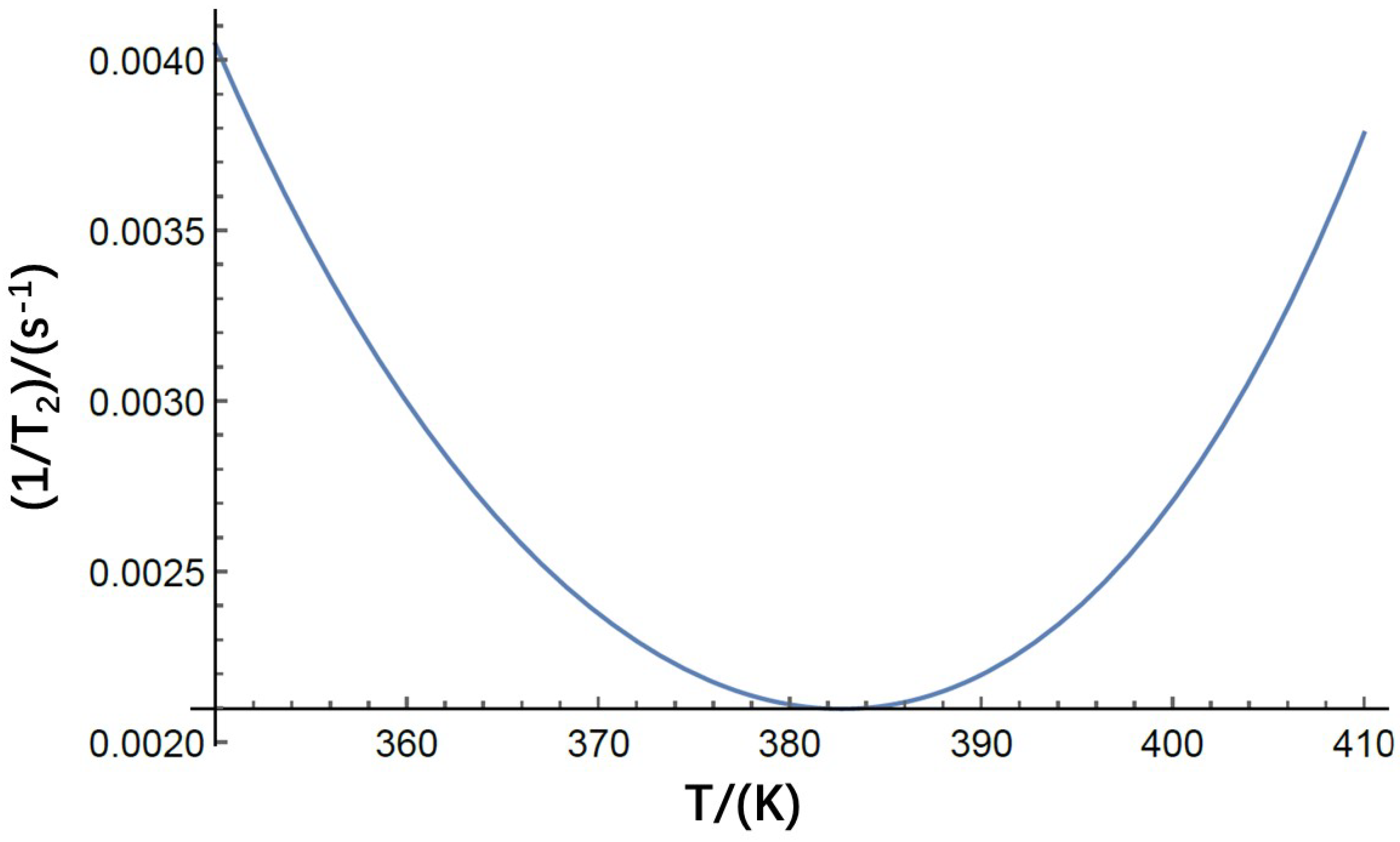

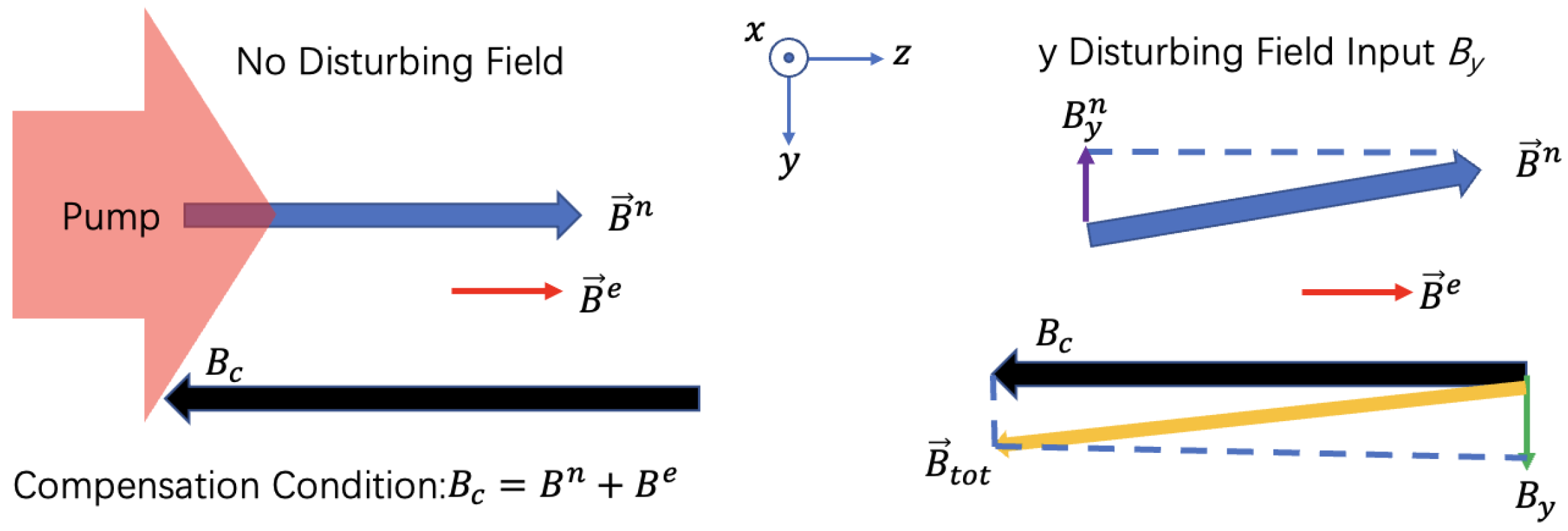

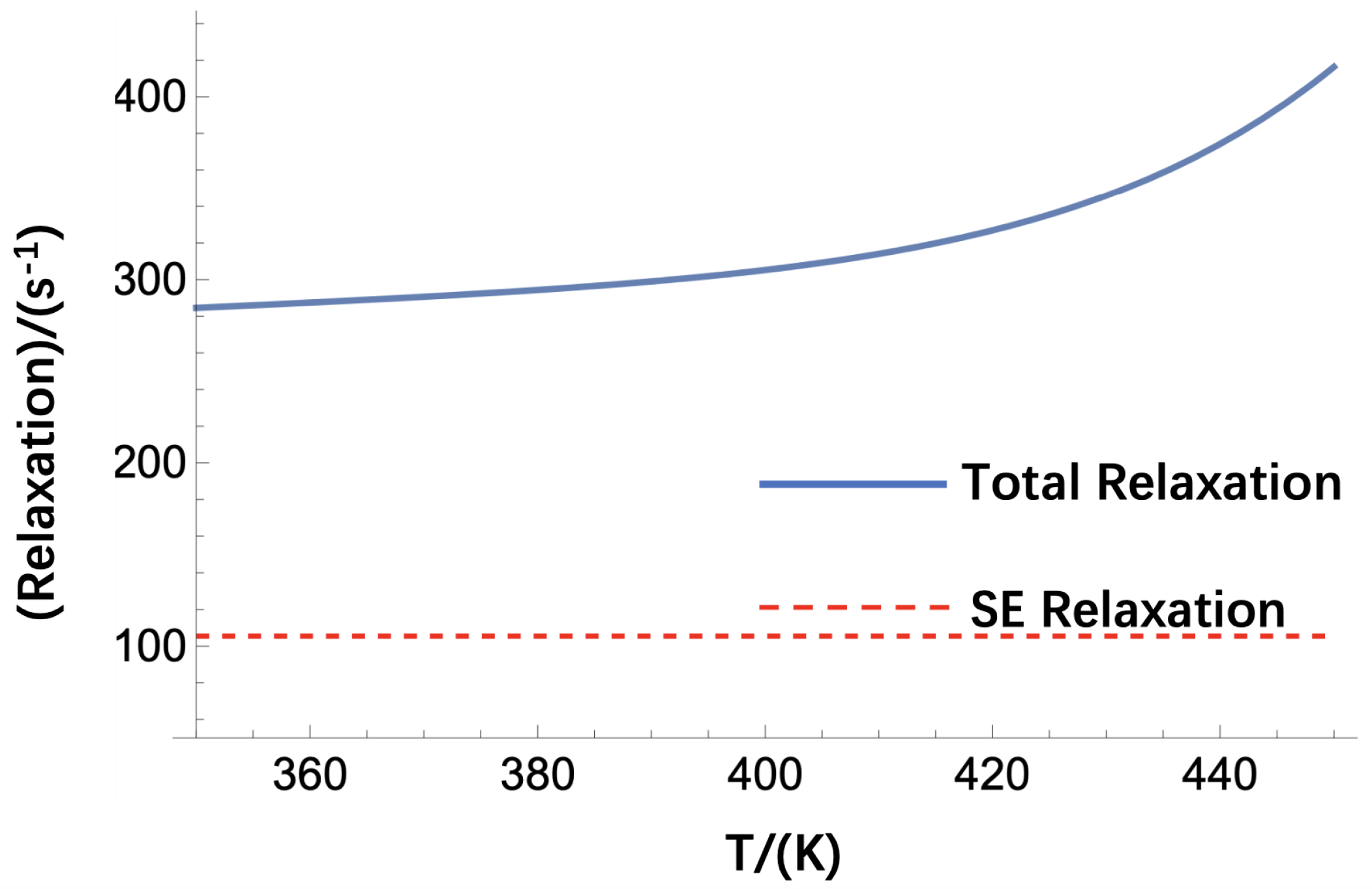

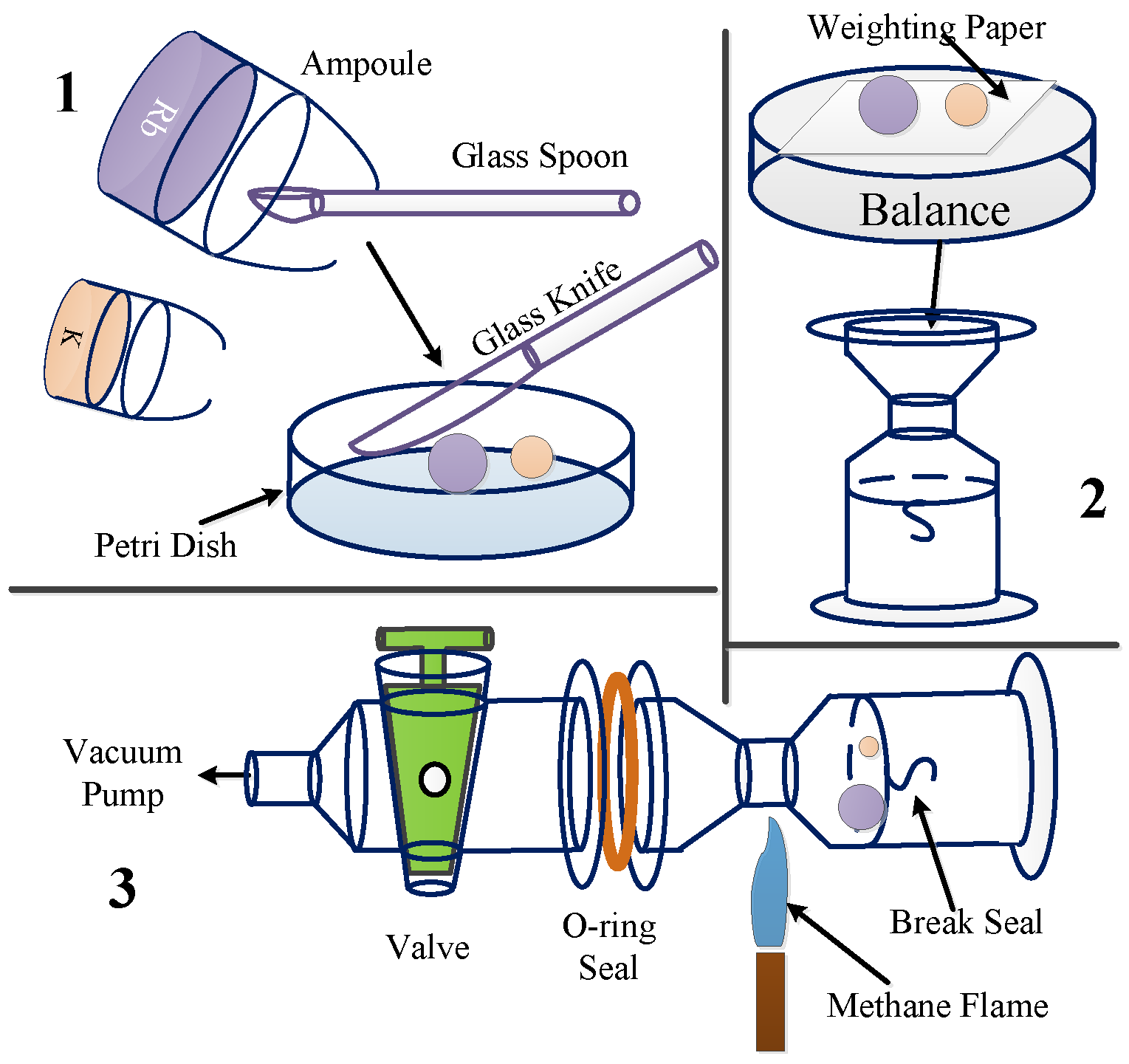
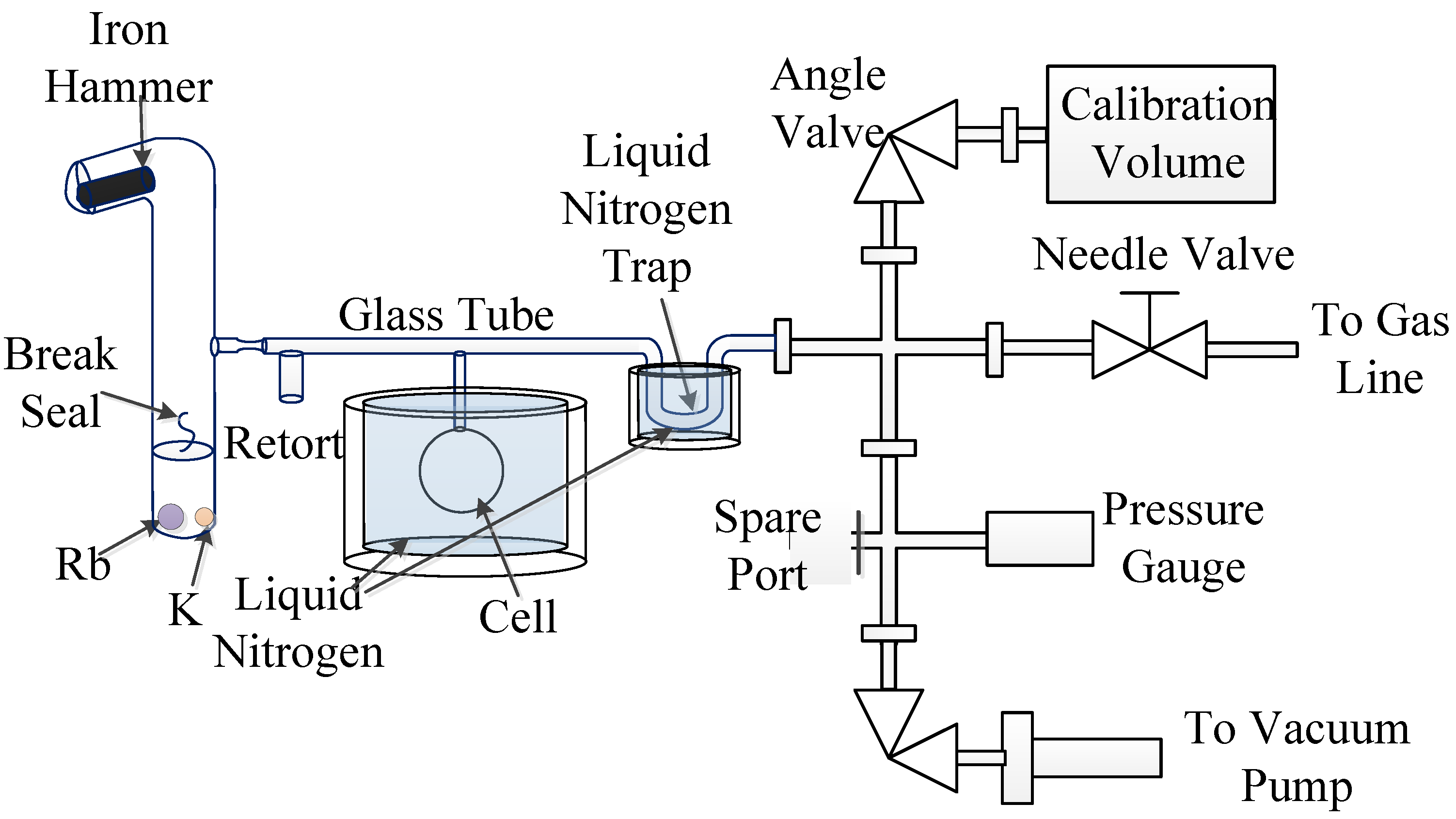
| Intended @463 K | (mg) | (g) | MFR of K | |
|---|---|---|---|---|
| 1/212 | 0.014 | 30 | 2.13 | 0.029 |
| 1/109 | 0.026 | 41 | 1.54 | 0.055 |
Disclaimer/Publisher’s Note: The statements, opinions and data contained in all publications are solely those of the individual author(s) and contributor(s) and not of MDPI and/or the editor(s). MDPI and/or the editor(s) disclaim responsibility for any injury to people or property resulting from any ideas, methods, instructions or products referred to in the content. |
© 2023 by the authors. Licensee MDPI, Basel, Switzerland. This article is an open access article distributed under the terms and conditions of the Creative Commons Attribution (CC BY) license (https://creativecommons.org/licenses/by/4.0/).
Share and Cite
Chen, Y.; Guo, R.; Wang, J.; Yu, M.; Zhao, M.; Zhao, L. Theoretical Study on Performing Movement-Related MEG with 83Kr-Based Atomic Comagnetometer. Photonics 2023, 10, 1302. https://doi.org/10.3390/photonics10121302
Chen Y, Guo R, Wang J, Yu M, Zhao M, Zhao L. Theoretical Study on Performing Movement-Related MEG with 83Kr-Based Atomic Comagnetometer. Photonics. 2023; 10(12):1302. https://doi.org/10.3390/photonics10121302
Chicago/Turabian StyleChen, Yao, Ruyang Guo, Jiyang Wang, Mingzhi Yu, Man Zhao, and Libo Zhao. 2023. "Theoretical Study on Performing Movement-Related MEG with 83Kr-Based Atomic Comagnetometer" Photonics 10, no. 12: 1302. https://doi.org/10.3390/photonics10121302
APA StyleChen, Y., Guo, R., Wang, J., Yu, M., Zhao, M., & Zhao, L. (2023). Theoretical Study on Performing Movement-Related MEG with 83Kr-Based Atomic Comagnetometer. Photonics, 10(12), 1302. https://doi.org/10.3390/photonics10121302







